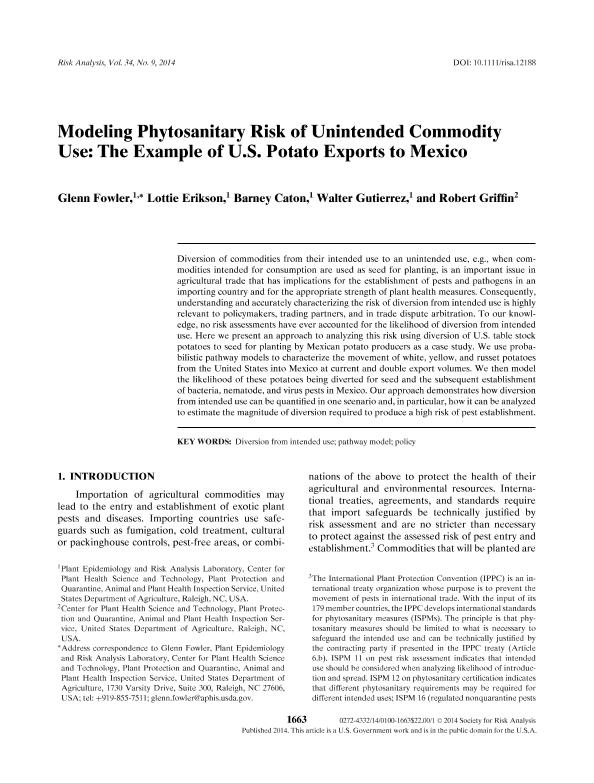Modeling phytosanitary risk of unintended commodity use : the example of U.S. potato exports to Mexico

Contenido multimedia no disponible por derechos de autor o por acceso restringido. Contacte con la institución para más información.
| Tag | 1 | 2 | Valor |
|---|---|---|---|
| LDR | 00000cab a2200000 4500 | ||
| 001 | MAP20140042654 | ||
| 003 | MAP | ||
| 005 | 20150130130423.0 | ||
| 008 | 141118e20140901esp|||p |0|||b|spa d | ||
| 040 | $aMAP$bspa$dMAP | ||
| 084 | $a7 | ||
| 245 | 0 | 0 | $aModeling phytosanitary risk of unintended commodity use$b: the example of U.S. potato exports to Mexico$cGlenn Fowler...[et.al] |
| 520 | $aDiversion of commodities from their intended use to an unintended use, e.g., when commodities intended for consumption are used as seed for planting, is an important issue in agricultural trade that has implications for the establishment of pests and pathogens in an importing country and for the appropriate strength of plant health measures. Consequently, understanding and accurately characterizing the risk of diversion from intended use is highly relevant to policymakers, trading partners, and in trade dispute arbitration. To our knowledge, no risk assessments have ever accounted for the likelihood of diversion from intended use. Here we present an approach to analyzing this risk using diversion of U.S. table stock potatoes to seed for planting by Mexican potato producers as a case study. We use probabilistic pathway models to characterize the movement of white, yellow, and russet potatoes from the United States into Mexico at current and double export volumes. We then model the likelihood of these potatoes being diverted for seed and the subsequent establishment of bacteria, nematode, and virus pests in Mexico. Our approach demonstrates how diversion from intended use can be quantified in one scenario and, in particular, how it can be analyzed to estimate the magnitude of diversion required to produce a high risk of pest establishment. | ||
| 650 | 4 | $0MAPA20080591182$aGerencia de riesgos | |
| 650 | 4 | $0MAPA20080608385$aRiesgos fitosanitarios | |
| 650 | 4 | $0MAPA20080617011$aExportación e importación | |
| 650 | 4 | $0MAPA20080592769$aProductos agrícolas | |
| 650 | 4 | $0MAPA20080621353$aEnfermedades de las plantas | |
| 650 | 4 | $0MAPA20080542085$aPlagas | |
| 650 | 4 | $0MAPA20080601522$aEvaluación de riesgos | |
| 650 | 4 | $0MAPA20080611613$aModelos probabílisticos | |
| 650 | 4 | $0MAPA20080571566$aCasos prácticos | |
| 651 | 1 | $0MAPA20080638337$aEstados Unidos | |
| 651 | 1 | $0MAPA20080637781$aMéxico | |
| 700 | 1 | $0MAPA20140025459$aFowler, Glenn | |
| 773 | 0 | $wMAP20077000345$tRisk analysis : an international journal$dMcLean, Virginia : Society for Risk Analysis, 1987-2015$x0272-4332$g01/09/2014 Volumen 34 Número 9 - septiembre 2014 , p. 1663-1676 |

